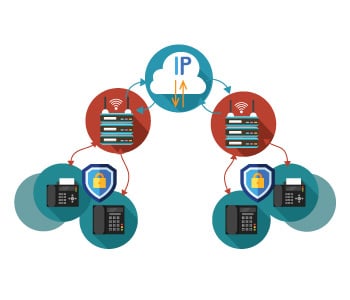Modem Relay | V. Modem Modulation Methods
Modem Over IP (MoIP)
V.150.1 specifies a protocol for transport of modem traffic between modems and telephony devices over an IP network
V.150.1 Modem interworks with other networks
V.150.1 Modem
V.150.1 – Modem Relay
Adaptive Digital’s V.150.1 software complies Minimum Essential Requirements (MER) of ITU-T V.150.1 specification for the modem relay over IP networks, that offers the best overall support for modem-type communication over IP and traversing across IP and circuit switched networks.
In addition, Adaptive Digital’s MER compliant software supports and interoperates with Secure Communications Interoperability Protocol (SCIP) devices on IP and PSTN networks.
As MER compliant software, it supports modem modulations according to ITU-T V-series recommendations: V.32, V.34, and uses Simple Packet Relay Transport (SPRT) protocol as IP Transport Layer Protocol (IP-TLP).
V.150.1 – Modem over Internet Protocol
The ITU-T V.150.1 recommendation defines interoperability procedures for PSTN and IP gateways. In a typical example of this setup, each dial-up modem connects to a modem relay gateway. The gateway is then connected to an IP network. The analog connection from the modem is terminated at the gateway and the signal is demodulated. Demodulated control signals are transported over the IP network. The gateway at the remote end receiving the packet uses that information to remodulate the signal for the modem attached to that end.
Features List
- MER compliant
- Interoperable with Secure Communications Interoperability Protocol (SCIP) devices
- Supports modem modulations according to ITU-T V-series recommendations
Demodulates and remodulates modem data at gateways, forwarding the data over IP between them.

Availability
Platforms Armv7-A, Armv8-A, Armv9-A | Armv7-M, Armv8-M x86_64 Texas Instruments – TI TMS320C7000 | TI TMS320C6000 | TI TMS320C5000
ADT Modem Software is available on the above Platforms: Other configurations are available upon request.
Voice band Modems V.32, V.32bis, V.34
V.32
V.32 – Duplex mode of operation on generalized switched telephone networks and two-wire point-to-point leased circuits
Important features of modems adhering to this standard are:
- The data signaling rate implemented in the modem is 9.6 Kbps or 4.8 Kbps
- The 9.6 Kbps data signaling rate uses two alternative modulation schemes that employ 16 carrier states and use Trellis coding with 32 carrier states. Modems that use this data signaling rate will also be able to work together by using 16 state alternatives.
- Channel separation using echo cancellation techniques
Modems that adhere to the V.32 standard incorporate a full-duplex echo canceler data modem that supports data rates ranging from 14.4 Kbps down to 4.8 Kbps in steps of 2.4 Kbps. The modulation methods adopted are quadrature phase-shift keying for 4.8 Kbps and QAM for the other data rates. The Trellis-coded modulations allow data rates of 7.2, 9.6, 12 and 14.4 Kbps, while non-Trellis-coded modulations support 4.8 and 9.6 Kbps. The symbol rate for every data signaling rate is approximately 2,400 symbols per second.
V.32bis
V.32bis – Allows up to 14.4 kbit/s bidirectional data transfer
This full duplex echo canceller data modem operates with trellis-coded modulation at 4.8, 7.2, 9.6 (TCM and non-TCM), 12.0, and 14.4 kbit/sec. The symbol rate for all data signaling rates is 2400 symbols/sec. The modulation methods are: QPSK at 4.8 kbit/s, rectangular 16-QAM at 9.6 kbit/s non-trellis coded modulation (TCM), rectangular 16-QAM at 7.2 kbit/s, modified cross 32-QAM at 9.6 kbit/s, rectangular 64 -QAM at 12 kbit/s, and modified cross 128-QAM at 14.4 kbit/s.
V.34
V.34 – Duplex and half-duplex modes of operation on GSTN and point-to-point, two-wire leased circuits
V.34 is an ITU-T recommendation for modems intended for use on connections on generalized switched telephone networks (GSTN) and point-to-point, two-wire leased telephone type circuits. V.34 permits a bidirectional transfer of up to 28.8 Kbps with additional defined data transfer rates of 24 Kbps and 19 Kbps respectively.
V.34 improves the handshake and connection process through a line-probing feature. It allows a V.34 device to choose operating parameters for a given connection. Following this stage, complex signals are transmitted that allow distant receivers to analyze connection characteristics before the data transmission stage. All connected devices make use of this line analysis to choose key operating parameters. A line-probing operation is performed on all new connections and is sometimes performed at selected times during connection as part of the retaining process. This allows devices to adapt to a broad range of distortions from one call to another and hold different line conditions over long time periods.